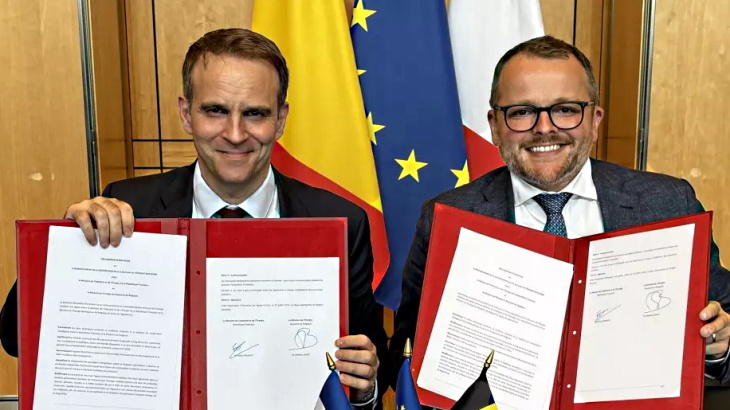In July 2025, France and Belgium signed a joint declaration on nuclear cooperation in Paris, marking a significant new chapter in bilateral nuclear relations. Belgian Energy Minister Tinne Van der Straeten and French Minister for Energy Transition and Industry, Roland Lescure, jointly announced that this partnership will span nuclear life extension, new build projects, and small modular reactor (SMR) deployment. The agreement reflects a shared political will to reconstruct nuclear cooperation mechanisms and reinforce European energy security.

The agreement was signed in Paris on 22 July by energy ministers Marc Ferracci (left) and Mathieu Bihet. Courtesy Mathieu Bihet.
This cooperation is not an isolated technical pact, but rather a natural extension of Belgium's nuclear policy shift and France's nuclear revival. On the Belgian side, the 2022 energy crisis caused by Russia’s war on Ukraine prompted a reassessment of the long-standing “nuclear phase-out” policy. In May 2025, Belgium repealed the 2003 Nuclear Exit Law, a landmark move that reopened the path for nuclear development. The repeal signals a strategic return to a diversified energy system grounded in low-carbon and dispatchable sources.
Minister Van der Straeten commented, “The repeal of the 2003 law opened a range of possibilities. We are now entering a new phase—one of concrete cooperation.” As part of this shift, Belgium’s nuclear safety authority approved the restart of the Tihange 3 reactor in July, with preparations for extending the life of the Doel 4 reactor also well underway. According to IAEA data, the four reactors still in operation are expected to supply around 57% of Belgium’s electricity in 2024, underscoring nuclear energy’s ongoing role as a cornerstone of the country’s energy security.
France, meanwhile, is rebooting its nuclear strategy on a larger scale. As one of the global leaders in nuclear power, France operates 57 reactors that generate approximately 67% of its electricity—higher than Slovakia (60%) or Hungary (47%). The French government has clearly framed nuclear energy as a triple pillar of energy sovereignty, industrial autonomy, and climate neutrality. EDF plans to build at least six new EPR2 reactors, with the first to be sited at Penly in northern France. The country is also accelerating SMR development and commercialization.
The Franco-Belgian partnership comes at a pivotal moment. The two nations possess complementary strengths across the nuclear value chain, laying a practical foundation for transnational collaboration. France brings a full industrial capability—fuel fabrication, reactor design, component manufacturing, and decommissioning—while Belgium offers operational expertise, a robust regulatory framework, and established research institutions such as SCK CEN and legacy infrastructure from the former FBFC. By jointly advancing life extension and SMR projects, Belgium can modernize its technical base, while France expands its nuclear influence within the EU.
This partnership also touches on deeper strategic questions of European autonomy and industrial security. In recent years, the EU has grown increasingly aware of the structural risks posed by energy dependency. Nuclear power, with its high energy density, low emissions, and baseload reliability, is once again being recognized as a dual-use tool for climate targets and energy resilience. Belgium has joined the EU-level “Nuclear Alliance,” which advocates for nuclear energy to be formally recognized as a clean energy source eligible for financing, technology support, and policy incentives. France, for its part, is using such agreements to consolidate its leadership in the EU's nuclear agenda.
Nevertheless, this bilateral cooperation faces several practical challenges. First is EU oversight on state aid and competition policy. Belgium’s nuclear life extension program has already received €2 billion in state support with approval from the European Commission, raising questions about future subsidies and the transfer of nuclear waste liability. Any direct involvement of French state-owned enterprises like EDF or Framatome in Belgian operations could invite further regulatory scrutiny. Second is the issue of public perception. Nuclear energy remains politically sensitive in Belgium, and any lack of transparency or environmental assurance could trigger public and political resistance.
Despite these hurdles, the France–Belgium agreement is widely seen as a symbol of Europe's broader nuclear revival. For over a decade, European nuclear development stagnated—constrained by the post-Fukushima policy freeze and a lack of investment in new technologies. Now, amid an accelerating energy transition and mounting climate urgency, nuclear power is being redefined as “critical infrastructure for green industry.” Its revival is seen as a means to enhance manufacturing capacity, secure energy supply, and achieve strategic autonomy.
In this context, the France–Belgium partnership is more than a technical cooperation—it could serve as a prototype for deeper integration of European energy policy and industrial strategy. If institutionalized and expanded into a platform model, such collaboration could attract more countries to jointly invest in fuel cycle R&D, coordinate SMR deployment, and standardize nuclear regulation. This would mark the emergence of a resilient, autonomous, and forward-looking European nuclear community.